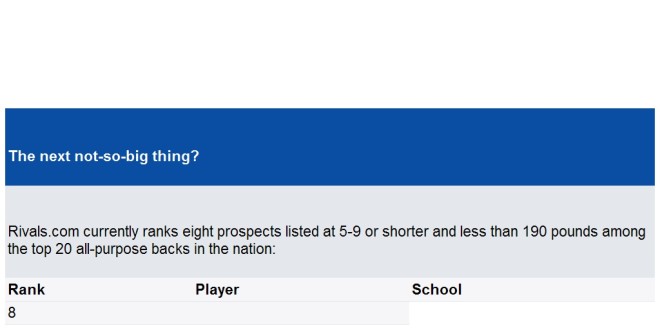Small backs making big splash



Advertisement








Speed always has been important in college football, but that appears to be truer than ever.
While coaches always will be enamored with big running backs who can shed tackles and wear a defense down, smaller running backs are making a splash on the national scene.
Last week, South Carolina took an early 7-0 lead at LSU and it appeared the Gamecocks might hold their own against the more talented Tigers. Shortly thereafter, 5-foot-6, 170-pound tailback/track star Trindon Holliday took a handoff from Matt Flynn, burst through a hole and was barely touched by Gamecocks defenders as he glided into the end zone.
Not many backs have the speed of Holliday, but several short running backs are making their presence felt in big-time college football.
Look no further than the current top three rushers. Michigan's Mike Hart, a Heisman Trophy contender, is 5-9. Kent's Eugene Davis is listed at 5-5 and 170 pounds, but he has rushed for 100 yards in each of his four games this year - two of which were against teams from BCS conferences. The nation's third-leading rusher is Idaho's Deonte Jackson, who is 5-8 and 181 pounds.
Other small but swift backs getting it done include 5-8, 186-pound Justin Forsett of Cal and Rutgers' Ray Rice, who has built his body up but came into college listed at 5-9 and 188 pounds.
West Virginia freshman sensation Noel Devine was the No. 1 all-purpose back in the nation last season despite checking in at 5-8 and 175 pounds.
The current crop of high school seniors contains several highly rated prospects of a similar mold, and one of them could be the next big thing in college football. Many of these are classified as all-purpose backs, a term usually describing a smallish runner who can do damage running the ball or as a receiver - out of the backfield or lined up in the slot. Many also will be special-teams standouts as well.

Carlton Thomas of Frostproof, Fla., is just 5-6 and 159 pounds, yet he boasts offers from schools such as Georgia, Iowa, Notre Dame and West Virginia. Thomas is expected to be utilized as a third-down back and slot receiver for whatever school he chooses, and Irish fans are envisioning him bringing his ability in space to a struggling Notre Dame offense.
Florida also is home to Jeff Demps, a 5-8, 162-pounder from Clermont who has narrowed his list to Florida and Tennessee and is one of the quickest players in the country.
Louisiana's Luther Ambrose holds an offer from Ole Miss and is listed at 5-9 and 160 pounds. Jacquizz Rodgers (5-6, 180) of Rosenberg (Texas) Lamar Consolidated has received offers from the likes of Arizona, Illinois, Oregon State and others.
Darius Ashley (5-8, 185) of Cincinnati is a key component on one of the top high school teams in the country and has narrowed his list to Louisville and Virginia. The Cavaliers would love to utilize him as they did with Alvin Pearman.
USC has accepted the commitment of 5-6, 180-pounder Curtis McNeal of Los Angeles Venice; his waterbug running style and flat-out speed could make him a miniature version of Reggie Bush.
A few others classified strictly as running backs break the prototypical mold.
Brandon Davis chose UCF after receiving offers from Maryland, Ole Miss, North Carolina, Purdue, South Carolina, Virginia Tech and others, in spite of being only 5-8 and 184 pounds. Davis has a thick lower body and is hard to get a clean shot on, so he could end up as an every-down back for the Knights. At the least, he'll be a matchup problem on third downs.
Kevin Whaley (5-9, 166) of Virginia Beach (Va.) Salem holds offers from UConn, Maryland, Virginia and Virginia Tech. He possesses enough athletic ability to convert to wide receiver, if needed.
The success of some short backs in college and beyond has opened the door for other prospects once thought to be too small to play in a major conference. As mentioned before, many will be special-teams players, returning kickoffs and punts, while others will be strictly used as "change-of-pace" backs, brought into utilize their speed and quickness after a bigger back has worn down a defense. Such a change of pace often is difficult for a defense to adjust to, and big plays are common.
While it seems smaller backs are having more of an impact in BCS conferences, a few things are likely to remain unchanged. Those players still will be more common at the mid-major level and they rarely carry the load themselves. Such prospects have been overlooked in college in the past and rarely get a look from the pros. But that, too, is changing. While 5-9, 180-pounder Warrick Dunn (FSU) once was the exception, smallish running backs such as Maurice Jones-Drew (UCLA), Brian Westbrook (Villanova), Leon Washington (FSU) and others are impacting the NFL.
Like the big wide receiver and the mobile quarterback, the smallish running back has become more and more coveted in the past few years.
As more and more such players make an impact at the pro and college level, we'll see more with major-college offers each year.
[rl]